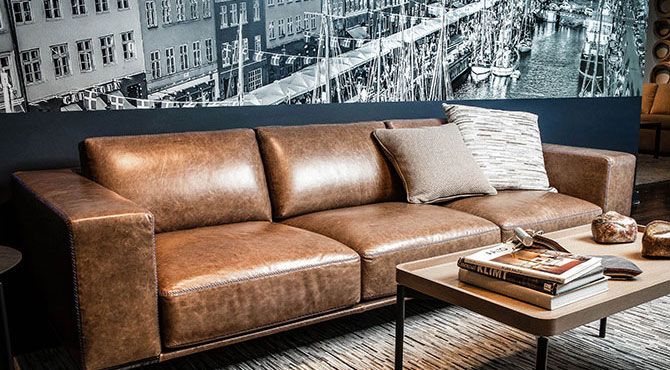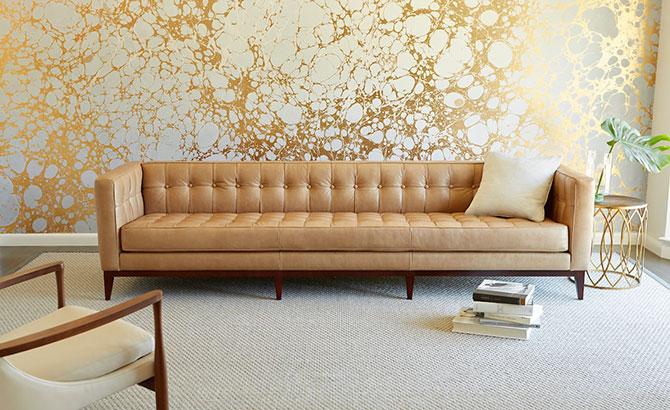Buying furniture is not always the easiest exercise and given how much time we spend on our furniture, the decision is an important one. However, to maximize the life and value you receive from your furniture, care and maintenance are required to maintain optimal condition. While regular vacuuming and prompt attention to spills and stains can help to preserve the appearance of sofas and other furniture, proper care in the form of using correct products and techniques may mean the difference between your furniture lasting a few years or decades.
Below are some tips to help you care for your leather or fabric furniture to maximize their life and comfort.
| HOW TO CLEAN LEATHER FURNITURE | |
 |
First, review the care label of your furniture. Under normal usage and conditions, regular dry-cloth dusting and vacuum cleaning in crevices and along the bottom are all that is necessary to clean your furniture. However, sometimes you may find yourself in need of a deeper clean, which require chemicals. Below are a list of materials that we do not recommend use on leather furniture. DO NOT USE: saddle soap, cleaning solvents, furniture polish, oils, varnish, abrasive cleaners, detergent soaps or ammonia water. Always try any cleaning method in a hidden area first to verify the results. For minor or slight scratches on the surface, use a soft cloth or clean fingers to gently buff the scratch. If needed, moisten lightly with distilled water to work scratches out. |
HOW TO CLEAN MINOR SPOTS AND SPILLS? |
|
| Wipe any excess liquid up immediately with a clean absorbent cloth or sponge. If necessary, use a lightly moistened soft cloth with distilled water and let air dry naturally. Do not dry with hair dryers, etc. Do not use soap or soak the stain heavily with water. This may cause more damage than the stain itself. If the stain persists, we recommend that a professional leather specialist clean the leather to avoid any potential damage to the leather |  |
HOW TO CLEAN TOUGH/STUBBORN SPOTS? |
|
 |
Moisten a soft cloth or sponge with a mild non-detergent soap and lukewarm water. Apply gently to all soiled portions of the leather surface. Remove soap lather by wiping with a clean damp cloth. Blot dry with another soft cloth, and then let air dry naturally. Do not use hair dryers, etc. If the stain persists, it is recommended that the leather be cleaned by a professional leather specialist to avoid any potential damage. |
HOW DO I CLEAN BUTTER/OIL/GREASE STAIN? |
|
| Blot excess butter, oil or grease off the leather with a clean dry cloth, then leave it alone. The spot should dissipate into the leather after a short period of time. Do not apply water or try to wash a butter, oil or grease spot. We also recommend the use of Leather Degreaser by Uniters.com to remove butter, oil or grease stains. |  |
HOW TO CLEAN FABRIC FURNITURE |
|
 |
First, review the care label on your furniture. Under normal usage and conditions, regular vacuum cleaning in crevices and along the bottom are all that is necessary to clean your furniture. Protect your furniture from sun and direct light. Like any upholstery material, fabrics can fade if exposed to the sun. Find the tag on the couch and read the instructions for how to clean upholstery. Here are the codes found on labels: SW: Means that a combination of dry cleaning solvents and water-based cleaners may be used. You should perform a spot test in an inconspicuous area. Professional cleaning may be required for overall dirt. S: Means this fabric is dry clean only, or require dry solvents. These fabrics may be damaged when using water-based cleaning methods. Use solvent cleaners in a well-ventilated room and keep away from open flames. Avoid using cleaning products containing carbon tetrachloride, as it is highly toxic. X: Use a vacuum only. No water. W: Clean only with water-based shampoo or foam cleanser. Do not over wet, and do not use solvents to spot clean. Piled fabrics may require brushing to restore appearance. DRY: Always try any cleaning method in a hidden area first to verify the results. The manufacturer is not responsible for damage incurred while cleaning |
